![]()
![]()
![]()
Use LEFT and RIGHT arrow keys to navigate between flashcards;
Use UP and DOWN arrow keys to flip the card;
H to show hint;
A reads text to speech;
61 Cards in this Set
- Front
- Back
|
1. The early genes of DNA viruses code primarily for proteins whose functions are required for:
A. transcription of viral mRNA B. translation of the capsid proteins C. replication of viral DNA D. processing of the mRNA precursors |
C. replication of viral DNA
|
|
|
2. Some viruses encode for a viral RNA-dependent RNA polymerase. Which of the following states a principle about viral RNA polymerases?
A. All RNA viruses carry RNA polymerase molecules inside virus particles as they are needed to initiate the next infectious cycle. B. Antibody against the viral RNA polymerase neutralizes virus infectivity. C. Negative-stranded RNA viruses supply their own RNA-dependent RNA polymerase as eukaryotic cells lack such enzymes. D. The viral RNA polymerase protein also serves as a major core structural protein in the virus particle. |
C. Negative-stranded RNA viruses supply their own RNA-dependent RNA polymerase as eukaryotic cells lack such enzymes.
|
|
|
3. A composite virus has been created that has the genome of molluscum contagiosum virus and the capsid of poliovirus. Which of the following genomes would the progeny viruses most likely have?
A. DNA B. Double-stranded RNA, segmented C. Negative-stranded RNA D. Positive-stranded RNA E. Circular double-stranded DNA |
A. DNA
|
|
|
List the negative sense RNA viruses: 6
|
Orthomyxoviridae
Paramyxoviridae Rhabdoviridae Filoviridae Bunyaviridae Arenaviridae |
|
|
Traits of Negative Stranded RNA Viruses:
-structural -important enzyme -replicate where? except for? |
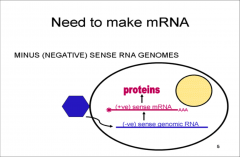
-All are enveloped and the nucleocapsid is helical.
-Carry own RNA-dependent RNA polymerase to synthesize viral mRNA. -Genome can be segmented or non-segmented. -Most replicate in the cytoplasm; exception is flu. |
|

|
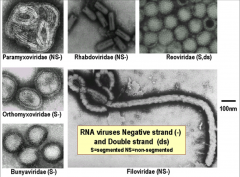
|
|
|
Orthomyxoviruses:
serotypes? severity by type? other general traits? |
-3 SEROTYPES:
*INFLUENZA VIRUS A *INFLUENZA VIRUS B *INFLUENZA VIRUS C -Severity of illness: A > B > C - No animal reservoir for B or C -Antigenic drift is associated with all 3 serotypes -Antigenic shift is associated only with type A -Segmented genome --> unstable --> mutations, especially A (animal mix creates new strains). -Acute virus, not chronic. |
|

|
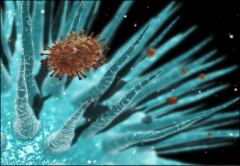
orthomyxovirus (flu)
|
|
|
How transmittable is flu?
How does it spread? What cells does it like to infect? |
-Highly contagious.
-Spread person to person through small particle aerosols that get into respiratory tract. -Attaches to and enters epithelial cells of the respiratory tract. -Immune defenses actually spread the virus from person to person (barrier protection in UR tract --> coughing) |
|
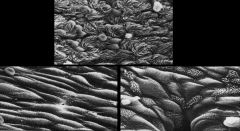
|
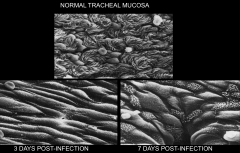
-Damage from flu opens door for other pathogens to get into respiratory tract --> 2˚ pneumonia, etc.
|
|
|
Describe the structure of orthomyxoviruses:
|
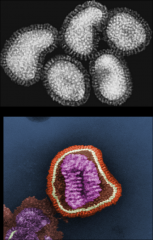
-Enveloped
-Pleomorphic -Segmented -Negative-stranded RNA genome; negative polarity -Replicates in the nucleus |
|
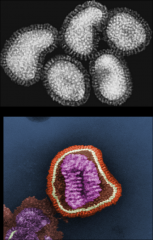
|
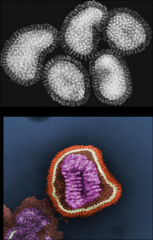
Orthomyxovirus (flu)
|
|
|
What determines the virulence of orthomyxoviruses?
|
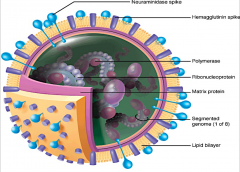
-Surface glycoproteins (hemagglutinin spikes) --> mediates attachment to epithelial cells.
-Neuraminidase spikes also play important role. -Matrix protein plays a role in viral budding. |
|
|
-Describe segmentation of the orthomyxovirus genome.
|
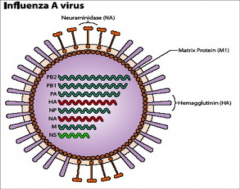
-8 genome segments
-RNA makes 4 associated proteins |
|
|
How does the flu virus achieve attachment and entry?
|
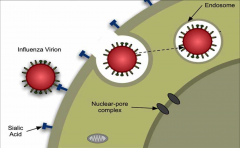
-Needs sialic acid receptor
-Binds to it using hemagglutinin spike; spike must be cleaved by respiratory serine protease; allows virion to enter epithelial cell and complete replication cycle. -Receptor-mediated endocytosis. |
|
|
Once the flu virion is inside a cell, how does it replicate?
|

-A drop in pH in endosome allows nucleic acid of virion to escape the endosome and head to the nucleus.
-Remember this nuclear replication is a special trait of the flu among RNA viruses. |
|
|
What is cap-snatching?
|
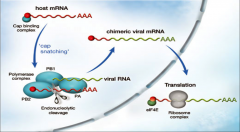
-Flu virions snatch the cap of host mRNA.
-This ensures the virus begins replicating immediately; forms a chimeric viral mRNA. -This is why the virion must replicate in the nucleus --> doesn't encode its own cap structure. |
|
|
Importance of Neuraminidase in flu virion?
|
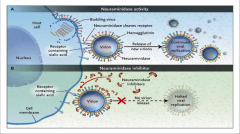
-Cleaves sialic acid.
-Allows newly replicated virion to get RELEASED and move on to another cell. -Some drugs inhibit neuraminidase to counter the virus. |
|
|
2 ways flu viruses can reassort their gene segments:
Which kind is worse for us? |
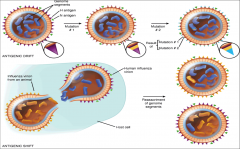
-antigenic drift
-antigenic shift-- worse, results in new viruses |
|
|
Describe antigenic drift in flu strains.
|
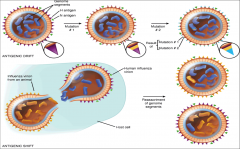
-Occurs when MUTATIONS arise in the HA and NA genes.
-Viable mutations lead to SLIGHT VARIATIONS in influenza viruses from year to year. -Occurs in types A, B and C. -Antigenic structures are changed, but the function of each is preserved. |
|
|
Describe antigenic shift in flu strains.
|
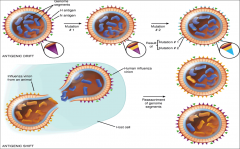
-Occurs when a cell is doubly infected with more than one type of influenza virus.
-Segmented genome facilitates REASSORTMENT of genes. -This leads to the emergence of TOTALLY NEW VIRUSES. -Occurs only in Type A (ANIMAL RESERVOIR required!). |
|
|
How often do totally new flu viruses emerge?
|
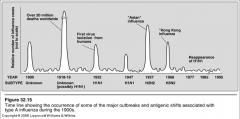
-epidemics every 20 years or so.
-most dangerous in young-ish people. immune system "too good" --> cytokine storm, inflammation. |
|
|
Comparison slide of orthomyxoviruses:
|

|
|
|
Describe the structural traits of paramyxoviridae:
-genetic traits -replication site -transmission via? |
-Spherical, enveloped particles that contain a non-segmented negative-strand RNA genome.
-Genetically stable. -Replication occurs in the cytoplasm. -They are transmitted in respiratory droplets and initiate infection in the respiratory tract. |
|
|
Describe the paramyxovirus family:
|

-Don't worry about the henipaviruses.
|
|
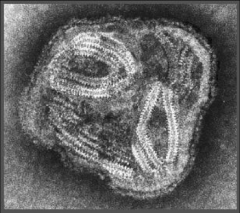
|
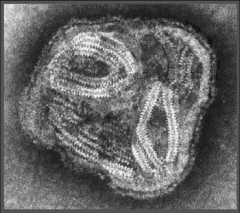
paramyxovirus
|
|
|
Important points about paramyxovirus structure:
|
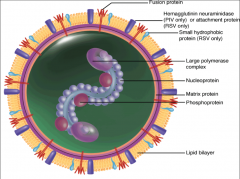
-Fusion protein --> doesn't use endocytosis
|
|
|
The mumps:
|
-Without widespread vaccination, (MMR attenuated vaccine) mumps is a common acute disease of children and young adults that is characterized by a nonpurulent inflammation of the salivary glands, especially the parotids.
|
|
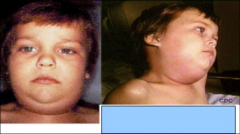
|
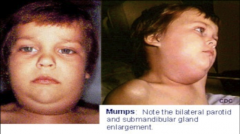
Mumps
|
|
|
What can happen if mumps is allowed to spread in a person?
|
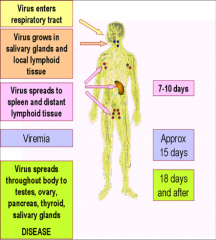
-Usually not an issue or self-limiting b/c of vaccination.
|
|
|
MEASLES:
|
-Rubeola
-One of the five classic childhood rashes. -Transmission is person to person via respiratory secretions. -Virus causes a systemic infection, disseminated by viremia, with acute disease manifestations involving the lymphatic and respiratory systems, the skin, and sometimes the brain. -Measles virus may persist silently for years and occasionally causes subacute sclerosing panencephalitis (SSPE) and autoimmune chronic hepatitis. |
|
|
Pathogenesis of Measles:
|
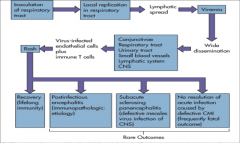
-Spreads by blood and lymphatics.
-Can in some cases spread to CNS --> SSPE (usually only in the immunocompromised). |
|
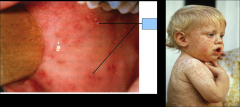
|
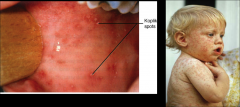
-Measles
-Mucosal Koplik spots show up early in the infection. -Skin rashes come later. |
|
|
Rhabdoviridae:
-structure -genera -who gets it? -when is it really dangerous? |
-Bullet-shaped with a helical nucleocapsid
-2 genera: Lyssavirus: rabies virus Vesiculovirus: vesicular stomatitis virus -Primarily a disease of animals (esp. bats). Most human cases in developing countries are due to dog bites. -Susceptibility to infection is related to the strain of virus, the host genetic background, amount of receptors in skeletal muscle, the size of inoculum, and the proximity to the CNS (i.e. neck bite is worse than a calf bite). -If it enters the CNS, ~100% fatal; luckily there's a long incubation period during which you can be treated. |
|
|
Structure of rhabdovirus:
|

-bullet shape
-Note surface G PROs --> facilitate binding to muscles. |
|
|
Pathogenesis of rhabdovirus infection:
|
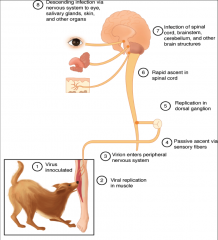
-Biting behavior encourages viral spread through saliva.
-Swallowing becomes very painful. |
|
|
Diagnosis of rabies:
|
-History of exposure and symptoms common to rabies.
-Negri bodies: eosinophilic cytoplasmic inclusions. |
|
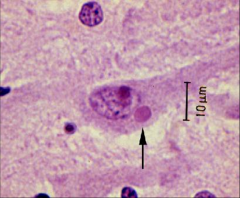
|
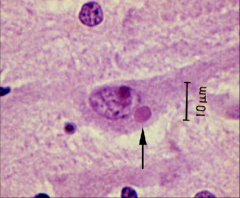
-Negri bodies in rabies post-mortem.
|
|
|
1. A 5-year-old child who has not had routine pediatric care developed a febrile disease with cough and a blotchy rash, and is brought to the emergency department. Physical examination shows cervical and axillary lymphadenopathy and an erythematous, maculopapular rash behind the ears and along the hairline, involving the neck and, to a lesser extent, the trunk. Examination of this patient’s oropharynx would likely show which of the following?
A. Cold sore on the lips B. Large shallow ulcers on the oral mucosa C. Multiple small white spots on the buccal mucosa D. Curdy white material overlying an erythematous base on the oral mucosa |
-It's measles
C. Multiple small white spots on the buccal mucosa |
|
|
2. Which of the following best describes the most likely casual virus?
A. Single-stranded, segmented, enveloped RNA virus B. Single-stranded, non-segmented, enveloped RNA virus C. Single-stranded, enveloped DNA virus D. Single-stranded, non-segmented, non-enveloped RNA virus E. Single-stranded, non-segmented, non-enveloped DNA virus |
Single-stranded, non-segmented, enveloped RNA virus
|
|
|
Which RNA virus is single stranded, segmented, with an envelope?
|
Influenza.
|
|
|
Which virus is a double stranded, enveloped DNA virus?
|
Herpes.
|
|
|
What are the positive sense RNA viruses?
|

|
|
|
-What's the basic ∆ b/t positive and negative sense RNA viruses?
-Basic key points about + sense RNA viruses: |
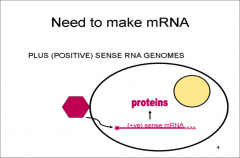
Key points:
-Genome serves as mRNA and is infectious -Genomes are non-segmented -Virions do not contain any enzymes -Structure: enveloped or naked; icosahedral or helical |
|
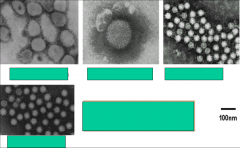
|
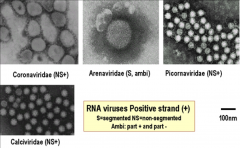
|
|
|
Family Tree of picornaviruses:
|
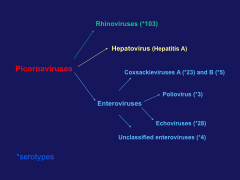
|
|
|
VIRAL ENTRY AND RECEPTOR SPECIFICITY of positive sense RNA viruses:
-picornavirus -rhinoviruses -poliovirus |
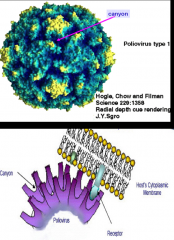
-The specificity of the picornavirus interaction for cellular receptors is the major determinant of the target tissue tropism and disease.
-Coxsackievirus and most rhinoviruses bind to ICAM-1. -Poliovirus binds to the cell surface glycoprotein known as CD155 (the poliovirus receptor). -The receptor on the cell surface binds in the CANYON and precipitates a conformational change in some of the viral proteins. This process facilitates the entry of RNA into the cell. |
|
|
DESCRIBE replication of positive sense RNA viruses:
|
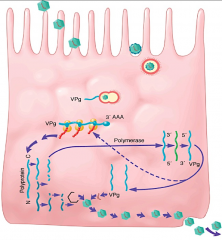
-endocytosis
-positive sense RNA is immediate translated into PRO. -Polymerase in one of the early products; used to generate more progeny. -eventual capsid construction and release (no budding here) |
|
|
Key points about enteroviruses:
-how do we get them? -where do they replicate? |
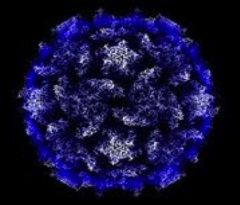
-Major portal of entry is the mouth via ingestion of contaminated food or water; transmitted by the fecal-oral route.
-Stable at low pH of the stomach, replicate in the GI tract, and are excreted in the stool. -Stable at room temperature. -Immunity is type-specific |
|
|
Summary of clinical syndromes and enterovirus serotypes:
|
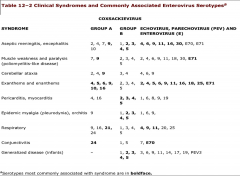
*Know which Coxsackievirus groups (A/B) are associated with disease syndromes*
|
|
|
Pathogenesis of enterovirus infection.
|
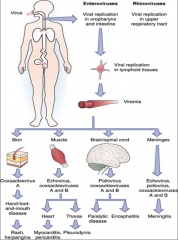
-The target tissue infected by the enterovirus determines the predominant disease caused by the virus.
-All enteroviruses have the ability to disseminate. *Aseptic meningitis is a common presentation* |
|
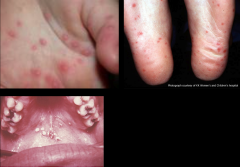
|
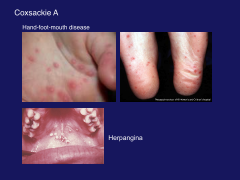
-herpangina- non-coalescing lesions on soft palate, adjacent to epiglottis.
-COXSACKIE A |
|
|
-PORTAL OF ENTRY OF POLIO?
-HOW DOES IT SPREAD? |
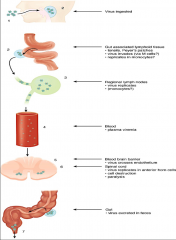
-Major portal of entry is the mouth via ingestion of contaminated food or water; transmitted by the fecal-oral route.
-Multiplies in throat and intestinal tract, enters bloodstream and spreads to brain and spinal cord. -Most infections are asymptomatic. |
|
|
Two types of the polio vaccine and pros and cons of each?
|
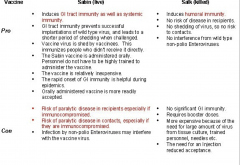
-live vaccine can spread in baby feces
|
|
|
Coronaviruses:
-shape? -what do they cause? |
-Enveloped and have a helical nucleocapsid.
-Largest positive strand RNA virus. -The second most prevalent cause of the common cold and have been implicated in gastroenteritis in infants. -Glycoproteins on surface of envelope appear as club- or petal-shaped projections that form a “corona” or crown around the virus. -A novel coronavirus was identified as the cause of a worldwide outbreak of severe acute respiratory syndrome (SARS) in 2002 |
|
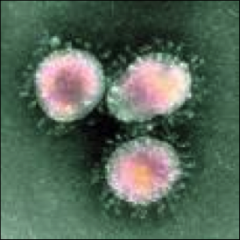
|
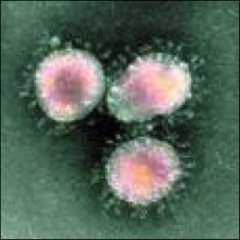
coronavirus
|
|
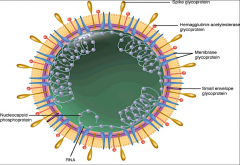
-What is this and why is its structure unique?
|
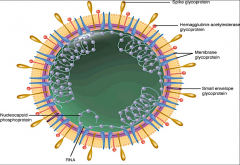
-coronavirus
-its glycoproteins are pretty unique in that they allow it to have some survival in the pH of the GI tract. -it's the only enveloped virus that can do this. |
|
|
CALICIVIRIDAE:
-structure -two genera? -stability/toughness? -transmission? -prevention? |
-Virions are non-enveloped and contain an
icosahedral capsid. -2 genera that contain human viruses: Norovirus (Norwalk and Norwalk-like virus) Sapovirus -Viruses are resistant to environmental pressure: detergents, drying, and acid. HARD TO KILL, LIKE STEVEN SEAGAL. -Transmission is via fecal-oral route. -Common cause of non-bacterial gastroenteritis. Major cause of epidemics (30-40%). -The key to preventing infection is to prevent contamination of food by correct food handling techniques and good hygiene. |
|
|
REOVIRUSES:
-structure -most important genera--what does it cause? -control |
(RESPIRATORY ENTERIC, ORPHAN)
Double-stranded RNA genome in 10-12 segments. Nonenveloped with double-layered protein capsids, each with icosahedral symmetry. Genera Rotavirus: Most common cause of severe DEHYDRATING diarrhea in infants and kids less than 3 years old. Control consists of rigorous hygienic measures, including careful handwashing and adequate disposal of enteric excretions. Live attenuated or reassortant vaccines have been developed and are available and recommended for infants. |
|
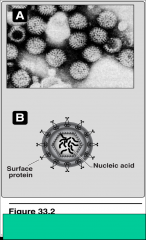
-What is this and what's unique about its structure?
|
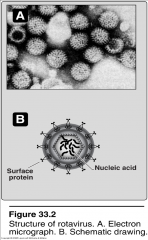
-Extra outside layer
-surface glycoPROs give it a wheel-like (rota) appearance. -RIGHT OUT THE ASH |
|
|
Pathogenesis of Rotavirus infection:
|
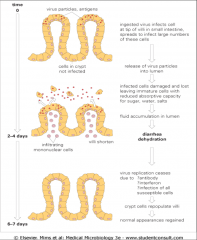
-CYTOLYTIC effects on GI tract.
|

